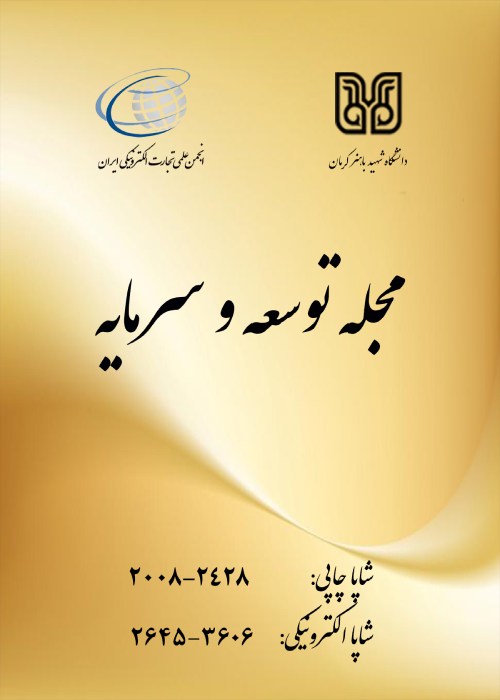Capital Estimation and Its Effect on the Growth of Manufacturing Industries in Iran
Author(s):
Article Type:
Research/Original Article (دارای رتبه معتبر)
Abstract:
Objective
In order to achieve economic growth, policy makers have always had a special look at the industry sector. As far as the industry is called the engine of economic growth. Therefore, the growth of the industry has always been considered, and policies have been adopted to accelerate it. The factors affecting the growth of the industry are divided into two categories of internal and external factors, and therefore, determining the contribution of each of these two categories in the growth of the industry can be a good guide in making macroeconomic decisions. Therefore, two objectives have been considered for this study. The first goal of this research is to estimate the capital stock of the manufacturing industries using data revised by the Iranian Statistics Center, and the second goal is to determine the contribution of internal and external factors affecting the growth of the manufacturing industries value added with a special view on capital as an internal factor. Method
The data used in this study is the time series of 2002-2019, and the Dadkhah and Zahedi (D-Z) method was used to estimate the capital stock of the manufacturing industries. The contribution of external and internal factors affecting the growth of the manufacturing industries is obtained by multiplying the production elasticity of the production factors in their growth using the Solow growth model. Also, the existence of a long-term relationship between the dependent variable and the independent variables has been investigated through the Pesaran bounds test. The long-term correlation coefficients were obtained using ordinary least squares regression and the error correction method (ECM) was used to estimate the short-term correlation coefficients of the variables. Results
After performing the unit root test, it was determined that all the variables used in the research were non-stationary at the level and after one time of differentiation, they were stationary. Therefore, for the existence of co-accumulation and the existence of the long-term relationship, the Pesaran bounds test was performed, and the cointegration between the variables was confirmed. Also, due to the existence of autocorrelation, by dividing the variables by the number of labors, they are included in the model per capita. Calculating variables such as the size of the government, exchange rate and the degree of the economic openness per capita have no meaning from an economic point of view, so the act of dividing has not been done for them. The results of the ordinary least square method have shown that in the long term, the amount of money per capita with a 32% share in the growth of the industry is the most influential external variable of this research, and after that, capital per capita is the second most important and effective factor on the said variable. Also, the third variable influencing the growth of the industry in the long term is the exchange rate with a share of nearly 7%. However, the coefficients estimated by the error correction method indicate that in the short term, the share of capital per capita and the volume of money per capita in the growth of the industry are 38 and 21 percent, respectively, and no other influential variable has been observed in the short term. The results of investigating the absence of heterogeneity of variance, autocorrelation, and collinearity problems using Hausman, LM, and variance inflation index (VIF) tests respectively for both OLS and ECM methods have shown that the aforementioned problems did not exist, and therefore, the results of this study are reliable. Conclusion
The results of this research, using the revised data of industrial workshops with 10 or more workers in the period of 2002-2019 and using the Solow growth model, indicate that in the short term, internal factors and in the long term, external factors have contributed the most to the growth of industrial production. It can be concluded that in the long term, the economic conditions at the macro level of the country and the economic variables affecting the performance of the industry sector, which are exogenously determined for it or in other words imposed on it, have had a greater contribution to economic sector growth than the variables that are in the decision-making sphere of economic units. The important point hidden in these results is that observing the effects of internal factors in the short term should not lead to neglecting the long-term effects of external factors and making policies with a short-term perspective. That is, paying attention only to making decisions that emphasize the internal factors of the industry, such as capital and labor, and making decisions at the macro level without considering the long-term effects on the industry sector, prevents the industry sector from reaching its potential growth.Keywords:
Language:
Persian
Published:
Journal of Development and Capital, Volume:8 Issue: 2, 2024
Pages:
51 to 71
magiran.com/p2684244
دانلود و مطالعه متن این مقاله با یکی از روشهای زیر امکان پذیر است:
اشتراک شخصی
با عضویت و پرداخت آنلاین حق اشتراک یکساله به مبلغ 1,390,000ريال میتوانید 70 عنوان مطلب دانلود کنید!
اشتراک سازمانی
به کتابخانه دانشگاه یا محل کار خود پیشنهاد کنید تا اشتراک سازمانی این پایگاه را برای دسترسی نامحدود همه کاربران به متن مطالب تهیه نمایند!
توجه!
- حق عضویت دریافتی صرف حمایت از نشریات عضو و نگهداری، تکمیل و توسعه مگیران میشود.
- پرداخت حق اشتراک و دانلود مقالات اجازه بازنشر آن در سایر رسانههای چاپی و دیجیتال را به کاربر نمیدهد.
In order to view content subscription is required
Personal subscription
Subscribe magiran.com for 70 € euros via PayPal and download 70 articles during a year.
Organization subscription
Please contact us to subscribe your university or library for unlimited access!


